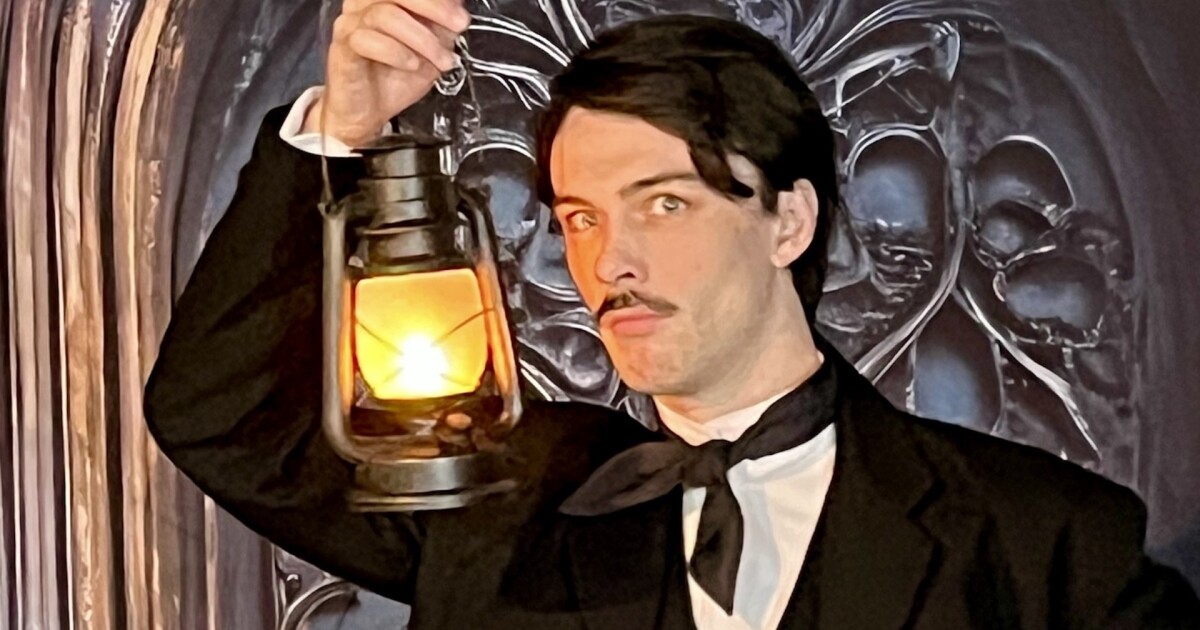This is WESA Arts, a weekly newsletter by Bill O’Driscoll providing in-depth reporting about the Pittsburgh area art scene. Sign up here to get it every Wednesday afternoon.
This time of year, we typically recall Edgar Allan Poe as the author of such macabre stories as “The Tell-Tale Heart” and anguished poems like “The Raven.”
But as Pittsburgh-based author Lawrence C. Connolly reminds us in his new play “Mr. Edgar A. Poe Presents Tales of Mystery, Horror & Imagination,” Poe was rather more, including the inventor of the modern detective story.
The juxtaposition of what Connolly calls “deduction and delusion” is one theme of the play, which gets its premiere production courtesy of Prime Stage Theatre Nov. 7 to Nov. 16 at the New Hazlett Theater.
The anthology-style show features Poe himself presenting, Crypt-Keeper style, four of his most famous works, and twice even stepping personally into the action. Art DeConciliis directs a cast of five, including Sam Lander as Poe.
Connolly, a veteran horror writer, does indeed aim to make your skin crawl with these renditions of “Tell-Tale,” “Raven,” “Murders in the Rue Morgue” and “The Fall of the House of Usher.” But he also wants audiences to take a fresh look at Poe.
Connolly actually wasn’t a big Poe fan until the past couple years, after Prime Stage produced his adaptation of Mary Shelley’s “Frankenstein.” The troupe’s artistic director, Wayne Brinda, asked whether he’d consider adapting Poe stories for the stage. Connolly began to delve.
“I was amazed at how much he had to show me about what I’m doing as a writer,” Connolly says.
Connolly was especially interested in Poe’s career decisions, including what he sees as Poe’s construction of the persona we know: a disheveled, mustachioed fellow all in black who looks like he hasn’t slept in a month.
In fact, Connolly says, for most of his life Poe sported a shaved lip (albeit with muttonchop sideburns) and favored an embroidered white silk waistcoat. But “he discovered that the mustache made an impression, a better impression, and fit the character better,” Connolly says.
That was especially true during the final years of Poe’s life, when he was regarded as quite an entertaining popular lecturer on topics literary. Some of his speeches in the play are drawn from historic transcripts.
Poe was truly tormented. He died in 1849, at age 40, after years of money troubles, personal tragedy and alcoholism. But today his work can feel like a still-fresh exploration of the light of reason as well as the shadows of madness.
“Murders in the Rue Morgue” finds C. Auguste Dupin — a “detective” before that was a thing — showing up the Paris police by using his powers of ratiocination to unravel a grisly killing. Meanwhile, Connolly’s take on the gothic masterpiece “House of Usher” makes Poe himself the protagonist unable to keep a haunted family from supernatural doom.
“Rue Morgue,” Connolly notes, revolves around the “calm, deductive” Dupin, who can “see the logic in the most chaotic details.” Roderick Usher, by contrast, “sees chaos in the most ordinary things.”
Connolly’s version of “Tell-Tale Heart” imagines Dupin (who’s not in the original) as a detective investigating the case. “The Raven” is largely a dialogue between Poe and his lost beloved, Lenore.
Connolly works mainly in horror, fantasy and science-fiction; his latest novel, “Minute Men: Execute & Run,” features heroes with severely time-constricted superpowers. As for Poe, he says, the master’s cannily self-made image has perhaps overshadowed his writing.
“Just as the Universal [Pictures] Frankenstein monster has become an icon readily recognizable, Edgar Allen Poe’s face and hair and mustache and black coat, these are things that are icons,” he says. “They define the horror genre, and he left us with those images imprinted on the mind so much more readily than a story.”
Connolly wants “Mr. Poe Presents” to change minds: “I think people are really gonna walk away from this with a whole new sense of who Edgar Allan Poe was.”

